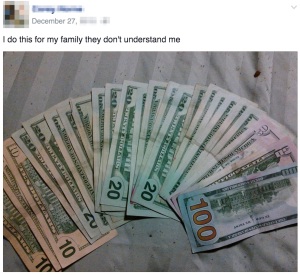Story of a thesis (Part II)

Last time, I told you all about Baltimore and how the situation there is kind of crazy with regards to gun violence in general and homicides in particular. Today, I’d like to tell you about what the publicly-available data tell us. However, I’m not talking about data in the traditional sense. The traditional data is easy to understand. You can plot points on a map and kind of get a sense of what areas of Baltimore are the ones where the most homicides are occurring. You can then map out social inequities and inequalities and see that these areas overlay well with those areas with violence.
It should not surprise you that data from either Baltimore City, the Baltimore Neighborhood Indicators Alliance, or any other source of data tells a story that is cold, mechanical. They’re just numbers on a spreadsheet. There’s no pictures of the people being hurt or those doing the hurting. For that kind of data, we turn to a very new and recent source: Social Media.
For this, I’m going to tell you a story. Person A was killed a few days ago while sitting in a car with a friend. The friend survived, barely. Person A has an Instagram account. (I won’t link to it because, even in death, Person A deserves some privacy.) On his Instagram account, Person A mourns the death of many friends and acquaintances. And I do mean many. I stopped counting at eight.
I don’t know about you, but I have not had that many people of my same age and in my social circle get killed. (Your mileage may vary.)
One of the people that Person A mourns is Person B. Person B was killed this past February. A comment on the post about Person B is from Person C. Person C refers to Person B as her “baby daddy” and writes about how much she will miss Person B. If you were to click on Person C’s Instagram profile, you would then see that she claims to be the “Mrs” of Person D. Person D was killed in October of last year.
In this small social network of four people, three of them are dead to gun violence in Baltimore City.
The story doesn’t end there. I looked through Person A’s other posts and he has similar social contacts as several other people who they themselves have lost someone to gun violence. In my rough social network map I created, I counted about 30 people, with 12 of them gone since the beginning of 2015. They all knew each other. They all talked to each other through Instagram, Facebook and Twitter.
Most of those who have been killed have posted pictures of themselves making gang signs with their hands, wearing gang colors, holding handguns, or flashing $100 bills at the camera, stating how great their lives “in the game” were. A couple of them even had well-produced rap videos about their lives in Baltimore and how they were respected and admired for their money and for the things they owned. And now they’re gone.
While this is only a small sampling of the social network of some of those killed in the last few weeks, it is quite astounding to me such a tight network of people — mostly young Black males — has such a high burden of all the homicides in Baltimore. It’s astounding because I’m looking at this from the outside as an epidemiologist. There’s an outbreak going on between these guys; Gun violence is spreading like a contagion.
This kind of finding would not be surprising to some researchers in Chicago. Papachristos et al found that a lot of the violence in Chicago could be attributed to a relatively small social network in that city. But their work is only the beginning of looking at violence as a contagion and understanding it. This is why my thesis will use social network data to map and analyze the relationships between victim and perpetrator, and between victim and other victims. It’s work that still has a ways to go:
“But the epidemiology of violence is still in its infancy, and as with any dimly understood virus, people are irrationally afraid of it—fearful they could pick it up on public transportation or by wandering into anywhere it’s been known to spread. Is it airborne? What kind of contact do you need to pick it up? What does “risky behavior” entail when it comes to catching a bullet instead of catching a cold?
Andrew Papachristos, a Yale sociologist, Chicago native, and graduate of Loyola and the University of Chicago, has spent much of his career thus far chasing these lines of transmission, literally building up social networks of violence from the traces people leave in the criminal-justice system before they’re shot or killed.
It’s a theory in its early stages, one Papachristos likens to the kind of epidemiological work made famous in the early years of the AIDS crisis, as the method of transmission was reverse-engineered from what victims did and who they did it with—and suggests the possibility that the treatment could be similar, to “flood the network with services” with support when a person is at risk.”
Indeed, it is necessary to quickly act on these outbreaks in order to contain them. When John Snow understood the transmission pattern of Cholera, he removed the handle from the water pump though he didn’t know that Vibrio cholerae was a thing. In the same way, we epidemiologists look at these things need to identify the “pump handle” of gun violence and intervene quickly and quite vigorously, lest we lose more young men to violence, young men with potential even if a lot of the society around them has pretty much given up on them.
I’ll tell you about some of these young men in the third part sometime soon.

Part I is here.
You’re reading Part II.
Part III will be here.
Part IV will be here.
Another great read. Patience paid off. 😉
“Most of those who have been killed have posted pictures of themselves making gang signs with their hands, wearing gang colors, holding handguns, or flashing $100 bills at the camera, stating how great their lives “in the game” were.”
And this is where you run into assorted arguments that boil down to “well, they deserved it”. These are very easy to make and very complicated to refute. They’re appealing because they explain a homicide (something very far outside of normal experience) without having to think about it too much. And who (besides Ren) wants to think much on the topic of homicide?
I hate because of how disrespectful it is of the deceased and their family/friends it is. Unfortunately, I know of no way to easily counter it and so I stay out of conversations about gun violence. “It could have been you had you grown up in that environment” fails to register with most people.
LikeLike
Forgot to mention, the social media mapping is ingenuous. Very much looking forward to the next installment.
LikeLike
“In this small social network of four people, three of them are dead to gun violence in Baltimore City.”
Oh, wow. I recently watched the movie “Chi-Raq” and it included how the small groups all affected each other (one big connection revealed at the end of the movie). Another interesting part of that movie was the depiction of social media and how it was used.
Sir, you have your work cut out for you. I applaud it, as much as I despise those in congress who have restricted research into gun violence by the CDC.
Out here in the far west we also have our share of urban gang violence. One more recent victim was a well loved artist, teacher and mentor. A suspect was arrested in January (informants and some surveillance video), he was a long time drug dealer.
I cannot diminish the anguish caused by the urban killings, but we have an added bit of gun violence: sovereign citizens and self described patriot militia. Over the past three months I have been obsessed with those that occupied a national wildlife refuge. These are also folks who pose in groups with their guns and use lots of social media. They seem to have their own interpretation of the US Constitution (I’m sorry, Ren, but despite you being nationalized they want to escort you over the border and not let you back… though my ex-Canadian hubby is okay dokay…. hmmm, thinking about your El Paso crossings, I assume you are familiar). They have a nasty habit of shooting police officers after being stopped for not having license plates nor driver’s licenses.
Unfortunately these clowns have support from some of our state legislators. A couple are in my state, and there are a contingent in Utah and Nevada that are fully behind these people. The same people who aimed high powered rifles at federal agents. One member of the Nevada Assembly and “patriot” supporter, Michelle Fiore, has an infamous Christmas card where everyone, including a toddler, is holding a firearm.
Oddly enough, the danger is not to those in their social circles but to law enforcement and to those of us who do not want to bend to their particular flavor of “freedom.” Which seems to be a freedom from diversity, traffic laws, taxes and other religions. There are some interesting similarities between your study group and the one around here that are a serious threat to public employees.
I have nothing else profound, but do note it is another angle on this country’s treatment of gun violence. (side note: the Bundy folks acted because the Hammond’s were put back in jail due to a federal “minimum sentence” law that was aimed at the demographic you are studying — oh, yeah it is okay for a minimum five year sentence on a black drug dealer, but not a white rural rancher who burned federal lands and threatened neighbors!).
Good luck on your thesis, it is an extremely important subject.
LikeLike
Oh, wow. I struggled to keep the number of links to just two, but I still got moderated. Okay, I need to share a couple of fun videos on how this whole “patriot” stuff shows that the demographic you are studying at least more intelligence that our western militia. (though if you want to get serious about the “patriot” racism read a few books by Dave Neiwert):
The Ballard of the Malheur Patriots:
Y’ll Queda: The Musical (longer, but better exposition):
Just to make sure you know why these anti-government guys are dangerous: Timothy McVeigh
And, yeah, the kids you deal with Baltimore have more brain cells than these clowns.
LikeLike
Rats. I do have a more serious comment, but it is moderation. I thought it was for two links… but the videos make it through! Yikes. Especially a link I wanted to include was the murder of a toddler as a version of “revenge”:
http://www.thenewstribune.com/news/local/crime/article50953770.html
LikeLike
We had one of those in Chicago. That article makes it look like the dad was targeted and the child killed by accident. In this one the child was the original target.
http://m.nydailynews.com/news/crime/suspected-chicago-gang-member-charged-killing-boy-9-article-1.2556563
LikeLike